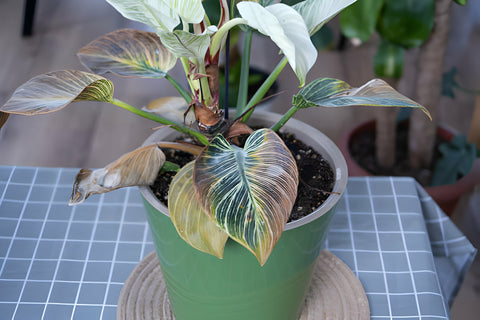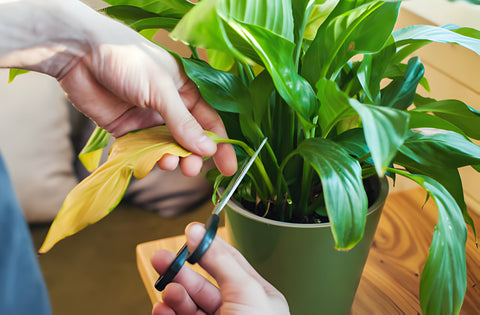When we talk about "houseplants," we usually think of our leafy companions thriving indoors in a cozy and well-regulated environment. However, many modern gardeners are taking the green adventure outdoors, cultivating their gardens in yards or on balconies. While an outdoor garden adds joy and vibrancy to your home, it also brings along its own set of challenges. From persistent pests to the unpredictable antics of wildlife and the whims of ever-changing temperatures, maintaining a thriving outdoor space demands resilience and attentiveness. Taking care of your garden is like solving a puzzle – you need to be strong and pay close attention. As the seasons transit from the warm summer to the freezing autumn and winter, one challenge looms larger in the cold months – frost.
Frost is a silent enemy that has the potential to cause serious harm to your plants if not promptly addressed. Frost damage in houseplants is a serious issue that arises when our typically warm-loving green companions are subjected to the harsh reality of freezing temperatures. This can happen more easily than we might expect, especially during the colder months or in gardens where insulation isn't optimal. When the temperature dips too low, it can trigger a cascade of physiological responses in plants that aren't equipped to handle such cold.
What is Frost Damage In Plants?
Frost damage occurs when plants, which are generally accustomed to stable and warm climates, face the unexpected and unforgiving chill of freezing temperatures. Normally, plants maintain a delicate balance within their cells, where water is both stored and utilized for various life-sustaining functions. However, when exposed to frosty conditions, low temperatures can cause freezing within the plant tissues. This freezing can harm cells and disrupt vital processes, leading to visible and often irreversible damage. The water inside plant cells forms ice crystals, causing cells to rupture and damaging cell structures. The once flexible cell walls now crack and split under the stress of ice formation. The result of this rupture is visible damage: leaves may first appear wilted as if pleading for water, not because they lack moisture but because their ability to transport it has been compromised by broken cell pathways.
Frost damage is more likely to occur during cold nights or sudden temperature drops, particularly in late spring or early fall when plants may not be acclimated to colder conditions. Vulnerable plants, especially those sensitive to cold, are at a higher risk of sustaining damage. Indoor plants that are placed close to drafty windows can also suffer from frost damage.

Frost damage is very harmful to houseplants.
How Harmful Is Frost Damage?
Frost damage is a significant threat to houseplants and can have far-reaching consequences for their health and survival. At the heart of the issue is the fact that many houseplants are not adapted to withstand freezing temperatures, which can cause the water within their cells to solidify into ice. This process is not just a surface-level concern; it goes deep into the cellular structure of the plant, where ice crystals form and expand, leading to potentially catastrophic outcomes.
As these sharp crystals grow, they can pierce through delicate cell walls, causing irreparable damage. The rupturing of cell walls leads to a loss of cell turgidity and function, disrupting essential processes such as photosynthesis and nutrient transport. The immediate effects of this cellular breakdown are often visible in the plant's appearance:
-
Physical Damage: The leaves may turn from healthy greens to sickly yellows or browns. The texture of affected foliage may also change, becoming soft or mushy as cell structure deteriorates. In severe frostbite cases, entire limbs or sections of the plant may blacken and die off completely.
-
Stunted Growth: A plant suffering from frost damage will often redirect its energy reserves from growth to repair and survival. This shift in priorities can result in noticeably slower growth rates or even a complete cessation of new development.
-
Increased Susceptibility: With its defenses down, a frost-damaged plant becomes an easier target for opportunistic diseases and pests looking for weakened hosts. Fungal infections and insect infestations can quickly take hold in plants already struggling with cold injury.
-
Weakened Growth: Frost damage can weaken a plant over time, diminishing its overall vigor and reducing its ability to flower or produce new growth in future seasons.
-
Plant Death: In cases where exposure to freezing temperatures is prolonged or particularly severe, plants may be unable to recover from the shock. Prolonged cold stress can result in plant death.
[Signs of Frost Damage]Signs Of Frost Damage In Houseplants
Frost damage in houseplants can be a serious issue, particularly for those that are not accustomed to cold temperatures. Here are some detailed indicators that your plant may have suffered from frost exposure:
-
Discoloration: The most immediate sign of frost damage is often a noticeable change in the color of the leaves. They may lose their vibrant green hue and turn pale green, yellow, or even white as the cold inhibits chlorophyll production—the pigment responsible for photosynthesis and the plant's green color.
-
Wilting: Plants affected by frost may exhibit wilting or drooping leaves. This wilting occurs because ice crystals form within the plant's tissues during freezing temperatures, disrupting the flow of water and nutrients within the plant and causing cells to collapse.
-
Blackened or Browned Foliage: As frost damage progresses, you might observe that parts of your plant begin to darken to black or brown hues. This discoloration is indicative of cell death in those areas where frost has irreparably damaged tissue.

-
Leaf Drop: A common response to stress in plants, including frostbite, is leaf drop. A plant will shed its damaged leaves more readily as it tries to conserve resources and protect its overall health.
-
Blisters or Water-Soaked Spots: Upon thawing out from a freeze, you might notice blisters on leaves or spots that appear water-soaked—these are areas where ice crystals have caused cells to rupture from within.
-
Stunted Growth: Frost-damaged plants often show signs of stunted growth following exposure to cold temperatures. New growth may be slow to emerge, undersized, or malformed due to the stress experienced by the plant's systems.
-
Translucent Patches on Leaves: Some plants develop translucent patches on their foliage where tissue has been damaged by freezing but hasn't yet turned fully yellow or brown—a precursor sign that these areas are likely compromised.
Houseplants That Are More Vulnerable To Frost Damage
Certain types of houseplants are more prone to frost damage, particularly those that are native to warm, tropical climates and have not evolved to withstand cold temperatures. Here are some examples of houseplants that are susceptible to frost damage:
-
Succulents: While some succulents like Sempervivum and certain Sedum species are cold-hardy, others such as Echeveria, Aeonium, and Crassula (Jade Plant) are vulnerable to frost.
-
Ficus Varieties: Popular indoor ficus plants like Fiddle Leaf Fig (Ficus lyrata) and Rubber Plant (Ficus elastica) prefer stable warm conditions and can be damaged by low temperatures.
-
Philodendrons: These plants are also prone to frost damage and need to be protected from freezing temperatures.
-
Ferns: Many fern varieties thrive in humid environments with stable temperatures and may struggle if the mercury falls too low.
-
Palms: Houseplant palms such as Areca Palm or Parlor Palm prefer a tropical climate and can be sensitive to cold drafts or frost.
-
Aloe Plants: Aloes generally enjoy warmer weather; exposure to frost can cause their water-filled leaves to freeze and become damaged.
-
Calatheas: With their origins in the rainforest understory, Calatheas do not fare well in cold conditions and may show signs of stress if temperatures drop too much.
[Treating Frost Damage]How To Treat Frost Damage In Houseplants
Treating frost damage in houseplants requires prompt and careful action to give your plants the best chance of recovery. Here's a step-by-step guide on how to address frost damage:
-
Immediate Relocation: As soon as you notice signs of frost damage, move the affected plant to a warmer location away from cold drafts or windows. Avoid placing it near heat sources that could shock the plant with sudden temperature changes.
-
Assess the Damage: Examine your plant thoroughly to determine the extent of the frost damage. Look for wilting, discoloration, soft or mushy areas, and any blackened or dead tissue.
-
Trim Damaged Parts: Using clean, sharp pruning shears or scissors, carefully remove any damaged leaves or stems. Cut back to healthy tissue to prevent decay from spreading further into the plant.

Prune damaged leaves or stems to help plant recover.
-
Insulate Your Plants: Insulate your plants if grown outdoors.
-
Allow Time for Recovery: After pruning, give your plant some time to heal before watering it again. This can help prevent additional stress and potential root rot while the plant is vulnerable.
-
Adjust Watering: Frost-damaged plants may have reduced water needs due to their compromised state. Water sparingly and ensure that the soil dries out between waterings.
-
Avoid Fertilization: Hold off on fertilizing until you see new growth indicating recovery. Introducing fertilizer too soon can overwhelm a stressed plant.
-
Monitor for Pests And Diseases: Keep an eye out for signs of disease or pest infestations that can take advantage of a weakened plant.
-
Provide Optimal Care Conditions: Once your plant is stable, continue providing it with ideal growing conditions—adequate light, proper humidity levels, and warmth—to support its recovery process.
[Preventing Frost Damage]How To Prevent Frost Damage In Houseplants
Prevention is always the best treatment. Preventing frost damage in houseplants is crucial, especially for those living in regions with cold winters or homes that experience significant temperature drops. Here are some strategies to protect your indoor plants from the cold:
-
Know Your Plants: You should find out each plant’s coldness tolerance, do not grow plants that are vulnerable to frost outdoors, or grow them in pots for easy relocation.
-
Keep Plants Indoors: Keep your frost-sensitive plants indoors, or bring them inside well before the first frost is expected.
-
Provide Protection for Outdoor Plants: For succulents and other plants that must remain outside:
- Mulch around the base of garden-planted succulents to insulate roots.
- Use frost cloths or plant blankets to cover sensitive species overnight.
- Construct cold frames or temporary greenhouses for added warmth and protection.
-
Avoid Drafty Areas: For indoor plants, keep them away from drafty windows, doors, and air vents. Cold drafts can quickly reduce the temperature around your plants, making them susceptible to frost damage.
-
Insulate Windows: Use insulating curtains or plastic window film during the colder months to create an additional barrier against the cold.
-
Monitor Weather Forecasts: Stay informed about upcoming cold weather conditions so you can take proactive measures to protect your plants from sudden temperature drops.
































































































